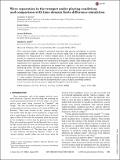Files in this item
Wave separation in the trumpet under playing conditions and comparison with time domain finite difference simulation
Item metadata
| dc.contributor.author | Kemp, Jonathan A | |
| dc.contributor.author | Bilbao, Stefan | |
| dc.contributor.author | McMaster, James | |
| dc.contributor.author | Smith, Richard | |
| dc.date.accessioned | 2013-08-13T14:31:01Z | |
| dc.date.available | 2013-08-13T14:31:01Z | |
| dc.date.issued | 2013-08 | |
| dc.identifier | 63301870 | |
| dc.identifier | 83f51feb-42f8-46b4-b7fd-9cae477adb49 | |
| dc.identifier | 84882436478 | |
| dc.identifier.citation | Kemp , J A , Bilbao , S , McMaster , J & Smith , R 2013 , ' Wave separation in the trumpet under playing conditions and comparison with time domain finite difference simulation ' , Journal of the Acoustical Society of America , vol. 134 , no. 2 , pp. 1395-1406 . https://doi.org/10.1121/1.4812254 | en |
| dc.identifier.issn | 0001-4966 | |
| dc.identifier.other | ORCID: /0000-0002-3861-4863/work/37034219 | |
| dc.identifier.uri | https://hdl.handle.net/10023/3958 | |
| dc.description.abstract | Wave separation within a trumpet is presented using three high pressure microphones to measure pressure waves within the curved, constant cross-section tuning slide of the instrument while the instrument was being played by a virtuoso trumpet player. A closer inter-microphone spacing was possible in comparison to previous work through the use of time domain windowing on non-causal transfer functions and performing wave separation in the frequency domain. Time domain plots of the experimental wave separation were then compared to simulations using a physical model based on a time domain finite difference simulation of the trumpet bore coupled to a one mass, two degree of freedom lip model. The time domain and frequency spectra of the measured and synthesized sounds showed a similar profile, with the sound produced by the player showing broader spectral peaks in experimental data. Using a quality factor of 5 for the lip model was found to give greater agreement between the simulated and experimental starting transients in comparison to the values in the range 1–3 often assumed. Deviations in the spectral content and wave shape provide insights into the areas where future research may be directed in improving the accuracy of physical modeling synthesis. | |
| dc.format.extent | 12 | |
| dc.format.extent | 2481921 | |
| dc.language.iso | eng | |
| dc.relation.ispartof | Journal of the Acoustical Society of America | en |
| dc.rights | Copyright (2013) Acoustical Society of America. This article may be downloaded for personal use only. Any other use requires prior permission of the author and the Acoustical Society of America. The following article appeared in JASA 134(2) pp. 1395-1406 and may be found at http://link.aip.org/link/?JAS/134/1395/1. | en |
| dc.subject | Brass | en |
| dc.subject | Wave separation | en |
| dc.subject | Trumpet | en |
| dc.subject | Physical modelling | en |
| dc.subject | Synthesis | en |
| dc.subject | Lip | en |
| dc.subject | Finite difference | en |
| dc.subject | QC Physics | en |
| dc.subject | ML Literature of music | en |
| dc.subject | Acoustics and Ultrasonics | en |
| dc.subject.lcc | QC | en |
| dc.subject.lcc | ML | en |
| dc.title | Wave separation in the trumpet under playing conditions and comparison with time domain finite difference simulation | en |
| dc.type | Journal article | en |
| dc.contributor.institution | University of St Andrews.Music Centre | en |
| dc.identifier.doi | 10.1121/1.4812254 | |
| dc.description.status | Peer reviewed | en |
This item appears in the following Collection(s)
Items in the St Andrews Research Repository are protected by copyright, with all rights reserved, unless otherwise indicated.

